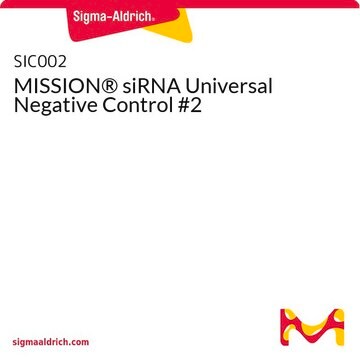SITRAN-RO
Roche
X-tremeGENE™ siRNA Transfection Reagent
Polymer reagent for delivering siRNA to common cell lines
About This Item
Produits recommandés
Qualité
for molecular biology
Niveau de qualité
Utilisation
sufficient for 2,000 transfections (04476115001)
sufficient for 400 transfections (04476093001)
Conditionnement
pkg of 1 mL (04476093001 [1 mg/ml])
pkg of 5 × 1 mL (04476115001 [5 x 1 mg/ml])
Fabricant/nom de marque
Roche
Concentration
1 mg/mL
Technique(s)
transfection: suitable
Conditions d'expédition
wet ice
Température de stockage
2-8°C
Catégories apparentées
Description générale
This innovative reagent forms a complex with siRNA, as well as with mixtures of siRNA and plasmid DNA (cotransfection), and efficiently delivers the nucleic acids into animal cells to induce gene silencing. Transfection is achieved in just a few steps: mix and incubate diluted transfection reagent with diluted siRNA, then add this complex to cells. Because X-tremeGENE siRNA Transfection Reagent functions exceptionally well in the presence or absence of serum and demonstrates low cytotoxicity, it can be used without media changes. The product is animal-component free.
Contents
Solution filtered through 0.2 μm pore size membrane, supplied in polypropylene tubes.
Application
Caractéristiques et avantages
- Knock down gene expression over 90% in many different cell types.
- Maximize experimental flexibility with a single reagent for siRNA- and cotransfection-based gene-knockdown experiments.
- Produce meaningful results using a reagent that exhibits low cytotoxicity, ensuring that the cellular effects you observe are due to the transfected siRNA rather than the transfection procedure.
- Work with or without serum, avoiding medium changes (e.g., to serum-free medium) before or after transfection.;
X-tremeGENE siRNA Transfection Reagent is a proprietary blend of lipids and other components, free of animal products.
Qualité
Cytotoxicity analysis: HEK-293 cells are exposed to siRNA/X-tremeGENE siRNA Reagent complexes for 72 hours in the presence of serum, without a media change. Cytotoxicity is then tested by analyzing the cells with the WST-1 Cell Proliferation Reagent (Roche).
Autres remarques
Informations légales
Produit(s) apparenté(s)
Code de la classe de stockage
12 - Non Combustible Liquids
Classe de danger pour l'eau (WGK)
nwg
Point d'éclair (°F)
does not flash
Point d'éclair (°C)
does not flash
Certificats d'analyse (COA)
Recherchez un Certificats d'analyse (COA) en saisissant le numéro de lot du produit. Les numéros de lot figurent sur l'étiquette du produit après les mots "Lot" ou "Batch".
Déjà en possession de ce produit ?
Retrouvez la documentation relative aux produits que vous avez récemment achetés dans la Bibliothèque de documents.
Les clients ont également consulté
Articles
Small inhibitory RNAs offer easy gene expression knockdown in mammalian cells, revolutionizing gene research.
Transfection introduces genetic material into cells, aiding research in gene expression and cell biology.
This brief webinar provides an overview of what transfection is and the methods that are used to introduce DNA or RNA into eukaryotic cells.
Genetic engineering enables large-scale expression and isolation of recombinant proteins for research purposes.
Protocoles
X-tremeGENE™ siRNA Transfection Reagent Protocol & Troubleshooting
Protocols for Transfecting Common Cell Lines with X-tremeGENE™ Transfection Reagents
Contenu apparenté
Browse our convenient transfection reagent selection guide to match the best reagent for your specific cell line and application needs.
Notre équipe de scientifiques dispose d'une expérience dans tous les secteurs de la recherche, notamment en sciences de la vie, science des matériaux, synthèse chimique, chromatographie, analyse et dans de nombreux autres domaines..
Contacter notre Service technique











